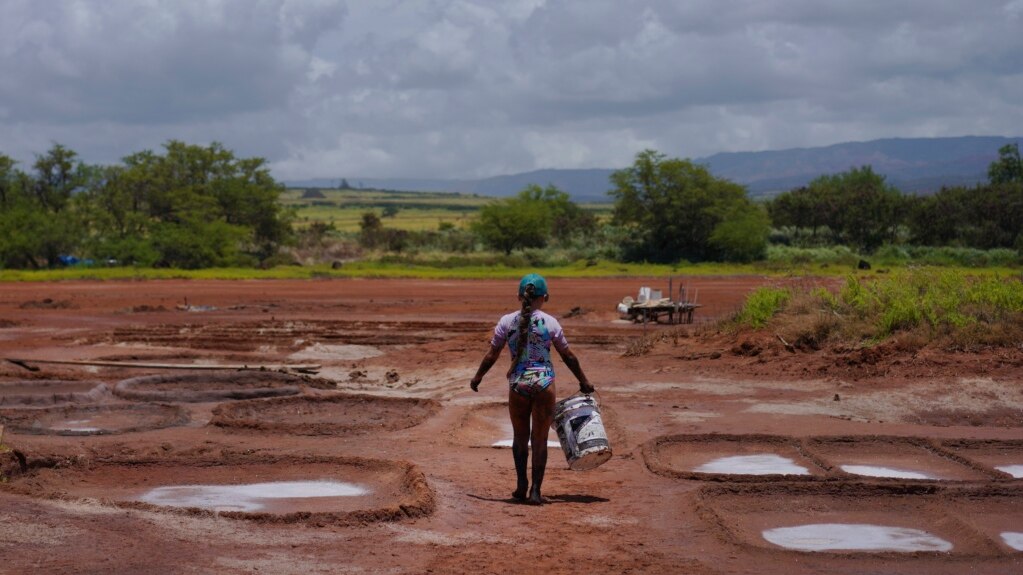Last summer on the Hawaiian Island of Kauai, Tina Taniguchi was working close to the ground. Her coconut leaf hat covered most of her thick brown hair. Wet soil had gotten on her clothes and her smiling face.
Taniguchi smiles a lot while working on the Hanapepe salt patch on the west side of Kauai. It is a piece of land about half a hectare in size with pools of salty water. The salt becomes crystals as the water dries.
"It's hard work, but for me it's also play," Taniguchi said with a laugh.
Spiritual tradition
Taniguchi's family is one of 22 families who make "paakai," the Hawaiian word for salt, following a cultural and spiritual tradition. Hanapepe is one of the last remaining salt patches in Hawaii. Its holy salt can be traded or given away but must never be sold. Hawaiians use it in cooking, healing, rituals and as protection.
Taniguchi drives a car for about an hour to get to the salt patch. For her, it is like religion and play at the same time. It is the time when she makes a spiritual connection to the land.
"This would be a religious practice of mine for sure," Taniguchi said. "My dad raised us saying that these mountains are his church, and the ocean is where you get cleansed."
Malia Nobrega-Olivera is another salt maker. She is also an educator and activist who leads efforts to preserve this old tradition. Her grandfather helped form the group of salt-making families called Hui Hana Paakai. The organization's goal, she said, is to communicate with the landowner, the state of Hawaii, whenever problems arise. Nobrega-Olivera said the salt patch is part of the lands taken away from Native Hawaiians after the U.S.-supported overthrow of Hawaii's monarchy in 1893.
Native claims to the land
"Regardless of what a piece of paper might say, we are stewards of the area," she said.
Over the past 10 years there have been several threats to this field. They include development, pollution from a neighboring airfield, damage to the sand from vehicle traffic and waste left by visitors to the nearby beach. In addition, rising sea levels and weather might stop the practice.
Nobrega-Olivera believes Western science and native knowledge can combine to combat the effects of climate change and save the salt patch. The steps she takes include building up the wells' edges, so water won't cover the salt beds. Another step is to prevent damage to the beach from vehicle traffic.
"Some ask us why we can't move this practice to a different location," she said. "That's impossible because our cultural practice is particular to this land. There are elements here that make this place special for making this type of salt. You cannot find that anywhere else."
The process of making salt
The process of turning sea water into salt can be slow. The season begins once the rain stops, and water starts to disappear from the salt beds. Ocean water travels underground and enters the wells. Each family has their own well. As water enters the well, so do tiny, red brine shrimp. These small ocean animals give Hanapepe salt its unusual, sweet taste, said Nobrega-Olivera.
The families first clean the salt beds and line them with black clay. Then they move water from the wells into the beds. There, salt crystals form. The top level, or layer, is the whitest. It is used for table salt. The middle layer is pinkish and is used in cooking, while the bottom layer, which is a deep red color, is used in blessings and rituals.
Fires on the island of Maui in August claimed 100 lives. After the fires, salt makers began sending their salt to survivors, so they can "make their food delicious and bring some of that joy into their lives," Nobrega-Olivera said.
Keeping traditions alive
Interest in Hawaiian culture and language has recently grown on the islands, Nobrega-Olivera said. She now thinks about how to teach her knowledge to younger generations.
One way she honors the Hanapepe salt patch is by writing Hawaiian songs and chants. She recently taught some school children one of those chants using the words aloha aina, which means "love of the land."
"Aloha aina captures our philosophy, the reason we do this," Nobrega-Olivera said. "You take care of the land, and the land takes care of you."
I’m Dan Friedell.
And I’m Jill Robbins.

